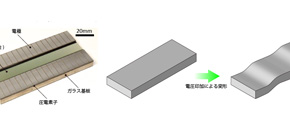
Successful formation of X-ray nanobeam capable of controlling beam size, a world-first
A step toward the realization of a multi-functional X-ray microscope
A group of researchers led by Professor YAMAUCHI Kazuto and Assistant Professor MATSUYAMA Satoshi (Graduate School of Engineering, Osaka University), Professor NISHINO Yoshinori (Research Institute for Electronic Science, Hokkaido University), and Director ISHIKAWA Tetsuya and Group Director YABASHI Makina ( RIKEN SPring-8 Center) succeeded in developing high-resolution deformable mirrors for X-rays and controlling the focusing spot size of an X-ray beam, a world-first.
This group verified the formation of different-sized (108~1434 nm) focused beams, nearly diffraction-limited, not by changing experimental settings but by only deforming deformable mirrors. This group developed a new X-ray focusing system at the large synchrotron radiation facility SPring 8. This system uses deformable mirrors developed by this group. By combining these 4 deformable mirrors, researchers can control the focused spot size without changing experimental settings, including the location of samples.
In this system, it’s possible to create focused optical systems with different numbers of numerical apertures only by changing the form of deformable mirrors, and controlling the focused spot size beyond the diffraction limit is possible by changing the number of numerical apertures. However, in order to focus to the diffraction limit, it is necessary to deform the mirror form to an extreme accuracy of 2 nm or less, which is equivalent to the height of 6 silicon atoms.
Therefore, this group developed an X-ray wavefront measurement method capable of detecting shape error of mirrors with considerable accuracy and controlled the deformation with an accuracy of 2 nm while monitoring the forms of the mirrors. This group carried out such procedures in three optical systems with different numerical apertures.
This system can deal with different X-ray wavelengths. In this experiment, this group used an X-ray wavelength of 1.24Å (X-ray energy was 10 keV). The smallest focused beam obtained by this group was a rectangle of 108 nm wide x 165 nm high, which was confirmed nearly diffraction-limited . Furthermore, the biggest focused beam was 560 nm wide x 1434 nm high, which also reached nearly diffraction-limited beam quality .
As nearly diffraction-limited beam size was achieved, it was verified that the deformable mirrors were deformed to an accuracy as designed and that all optical systems created by this group worked ideally. It is anticipated that a multi-functional X-ray microscope capable of performing various microscopic analyses will be achieved through the application of this group’s achievement.
Abstract
Unlike the electrostatic and electromagnetic lenses used in electron microscopy, most X-ray focusing optical systems have fixed optical parameters with constant numerical apertures (NAs). This lack of adaptability has significantly limited application targets. In the research described herein, we developed a variable-NA X-ray focusing system based on four deformable mirrors, two sets of Kirkpatrick–Baez-type focusing mirrors, in order to control the focusing size while keeping the position of the focus unchanged. We applied a mirror deformation procedure using optical/X-ray metrology for offline/online adjustments. We performed a focusing test at a SPring-8 beamline and confirmed that the beam size varied from 108 nm to 560 nm (165 nm to 1434 nm) in the horizontal (vertical) direction by controlling the NA while maintaining diffraction-limited conditions.

Figure 1. Developed deformable mirror

Figure 2. Schematic of variable-NA focusing optical system. The two deformable mirrors are arranged perpendicular to each other (KB configuration). The variable-NA X-ray focusing system base on two sets of the mirror system were constructed (upper figure). The lower figure shows the schematic ray diagram.

Figure 3. Beam profiles of the formed X-ray nanobeam. The dots and the solid lines show experimental and simulated results, respectively.
To learn more about this research, please view the full research report entitled " Nearly diffraction-limited X-ray focusing with variable-numerical-aperture focusing optical system based on four deformable mirrors " at this page of the Scientific Reports website.
Related links
- RIKEN Press release
- Outline of Dr. Yamauchi's Research ( Core Research for Evolutionary Science and Technology (CREST), Japan Science and Technology Agency (JST) (in Japanese)
- Yamauchi Laboratory, Department of Precision Science and Technology, Graduate School of Engineering, Osaka University (in Japanese)
- EurekAlert!
- AlphaGalileo
